The 2023 Toyota Highlander remains a strong three-row SUV choice, if you choose the hybrid. It's amazingly efficient, delivering 35 mpg combined with all-wheel drive. Not only is it a huge advantage over the conventional gas-powered Highlander, it represents a huge advantage over virtually every other SUV in its class.
On the flip side, there's the conventional Highlander. And now, it's a worse SUV to drive. Toyota dropped the silky V6 in favor of a turbocharged 2.4-liter four-cylinder. It apparently has fewer emissions than the V6, but with a single mile-per-gallon improvement and a much noisier, more unpleasant driving experience, it's a downgrade in our book.
Regardless of engine, you still get solid handling, an attractive and usable interior, and Toyota's reputation and subsequent resale value. A smaller third-row seat and cargo area are definite demerits, especially in a class where space is a prime factor in the purchase, and because of that, options such as the Kia Telluride, Hyundai Palisade, Subaru Ascent and Nissan Pathfinder could be better for you.
If you don’t need that much room, however, the Highlander Hybrid is an unmatched option for its efficiency, and is definitely worth a look. The non-hybrid Highlander? Not so much.
Interior & Technology | Passenger & Cargo Space | Performance & Fuel Economy
What it's like to drive | Pricing & Features | Crash Ratings & Safety Features
What's new for 2023?
The Highlander has dropped its V6 engine option in favor of a turbocharged 2.4-liter four-cylinder. It delivers less power, but much more torque. It's also very slightly more efficient. The infotainment system has been updated to run on the system featured on other new Lexus and Toyota models. The standard touchscreen measures 8 inches, and the upgraded one is 12.3 inches. It also features wireless Apple CarPlay and Android Auto compatibility. Some minor feature changes for some trims have also been implemented.
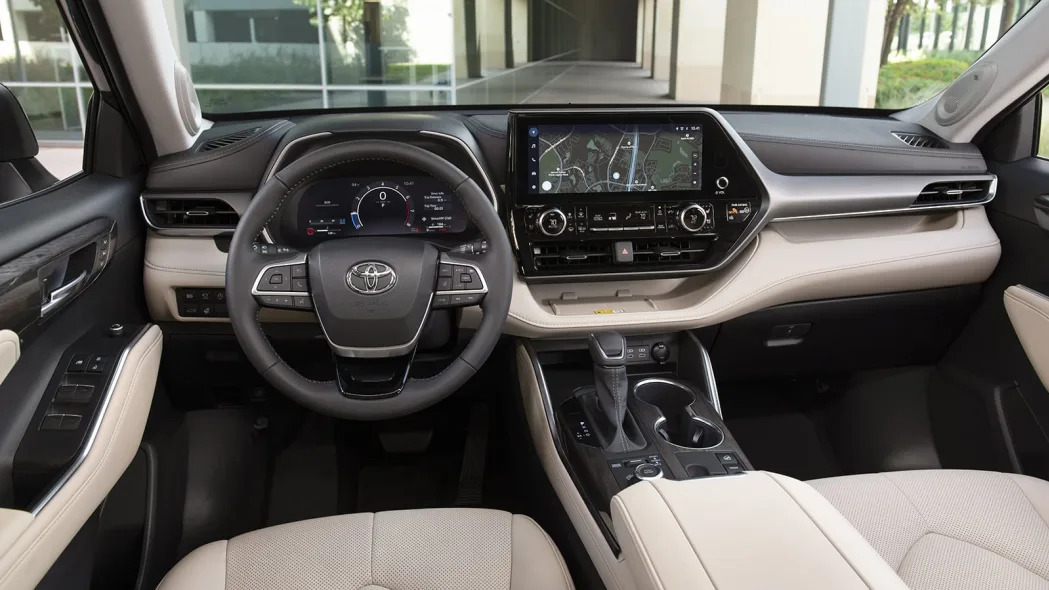
What are the Highlander interior and in-car technology like?
Admittedly, the picture above is indicative of the higher XLE, Limited and Platinum trims – the lower L and LE are rather dour and monochromatic affairs. Yet, even those have above-average interior quality, and since those pricey trims tend to be popular, it's worth extolling their virtues a bit. The earthy two-tone color schemes are distinctive, warm and generally inviting. The silver trim that wraps around the control binnacle like a fork is textured to make it look richer and more like actual metal. The wood trim on the dash and center console, be it real or not, is subtle and tasteful. The padded SofTex vinyl that covers much of the dash, doors and center console is pleasant to touch, while the real leather on the seats is buttery soft. All the switchgear is pleasant to touch and operate.
Standard on most trim levels is an 8-inch touchscreen interface, which is mounted high within easy reach and sight. The available 12.3-inch unit is largely similar in terms of its basic and operation, but gains functionality by adopting a widescreen orientation. The operating system is the newest that Toyota has to offer, featuring bright, minimalist graphics and natural speech recognition. It's responsive and runs quickly. The shortcut icons on the side closest to the driver are easy to reach, but they unfortunately disappear when you use Apple CarPlay or Android Auto, meaning you have to click-click-click to escape the Apple/Android interfaces rather than using a simple Home button like Toyota used to feature. There are other annoyances we discovered, particularly with the radio operation, that can make the new system less user-friendly than Toyota’s previous ones.
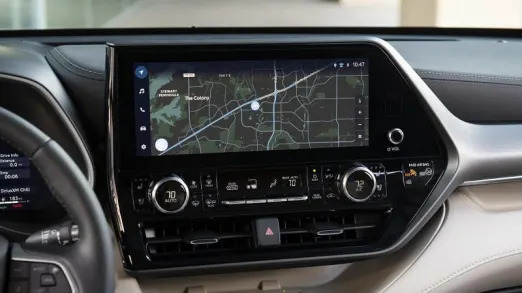

How big is the Highlander?
The Highlander is smaller than most of its competitors on the outside, which makes it slightly more manageable to maneuver and park. Perhaps there's a greater chance of it fitting inside your garage. We're only talking a few inches, though, as the Highlander is still an awfully big vehicle.
Not surprisingly, though, it also has one of the segment's smallest interiors. It's more akin to Kia's Sorento than the bigger Telluride, for instance. There's just a bit less headroom everywhere, but it's the third row that's noticeably much smaller than those of competitors. Even the Subaru Ascent, which has comparable exterior dimensions, can fit average-sized adults in its third row. So too can the larger Kia Telluride and Hyundai Palisade among others. Even if kids are the ones who frequently use third-row seats, they will be less comfortable in the Highlander’s.
At least the second row offers plenty of space (a bench is standard but you can opt for captain's chairs), and the sliding seats are mounted at a height that allows adults and teens to be comfortable for hours on end. Comfort is excellent up front, too, as the driver seat offers abundant adjustability and easy reaches to the steering wheel and infotainment controls.
Cargo space comes in at 16 cubic feet behind the third row of seats, 48.4 cubic feet behind the second row, and 84.3 with all the rear seats folded. Despite the solid numbers, the Toyota still offers less space when all the seats are raised based on our luggage test of the Highlander as well as those of its competitors. There's less when they're lowered too, but that isn't as much of an issue since you're basically dealing with varying degrees of enormous.


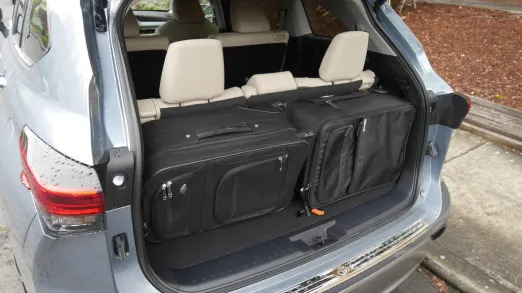
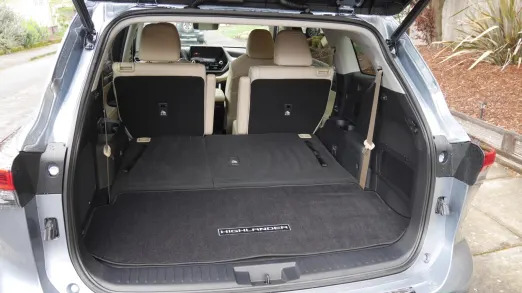
What are the Highlander fuel economy and performance specs?
Here's where the Highlander is a big winner, at least in regards to the hybrid. The electrified Highlander uses a 2.5-liter four-cylinder paired with electric motors that produce a net output of 243 horsepower. That isn't much for the segment, but then no large three-row crossover comes close to its fuel economy. EPA estimates weren’t available for 2023 at the time of this writing, but we anticipate them to be virtually the same: 36 mpg combined with front-wheel drive or 35 mpg with optional all-wheel drive (it uses a second electric motor at the rear axle).
The turbocharged four-cylinder on the other hand should be skipped if possible. Unlike the silky outgoing V6 with impressive horsepower for its class, the turbo engine is loud, clattery and has less horsepower than most competitors. It does feature much more torque than most at 310 pound-feet (an increase of 47 versus the outgoing V6), but the rough-sounding engine makes it sound like it's laboring harder. And while Toyota claims reduced emissions, the owner doesn't reap much of an efficiency benefit from the turbo engine. Full numbers haven't been announced, but it apparently delivers 25 mpg in combined driving, a 1-mpg improvement over the V6. Presumably, these numbers are for the front-wheel-drive models.
The good news is that the turbo engine retains the smooth and fairly responsive eight-speed automatic. Front-wheel drive is standard, and two all-wheel-drive systems are available: a basic one that sends power to the rear wheels when extra traction is needed, and a more advanced system for the XSE, Limited and Platinum that can also differ the amount of power between the left and right rear wheels to further enhance traction (AKA torque vectoring).
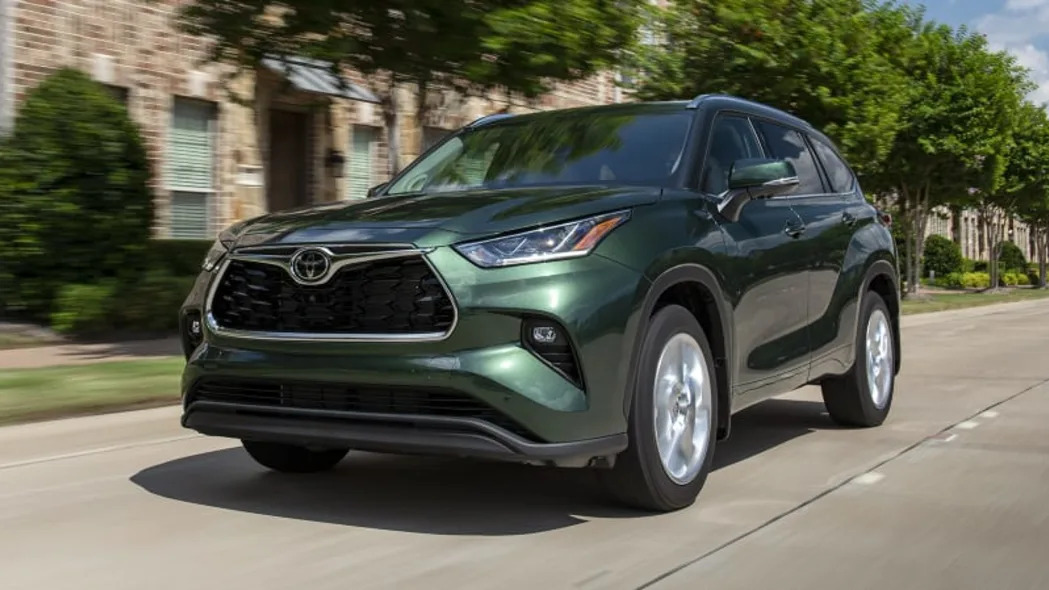
What's the Highlander like to drive?
This is by far the best Highlander to drive yet, and is also one of the most composed vehicles in the segment. It doesn't feel that big behind the wheel, and the chassis and steering work nicely in concert with each other to create a driving experience that feels consistent regardless of whether you're driving the kids to school, on a long highway trip or find yourself on a winding mountain road. It's not an athlete like a Mazda CX-9, and we doubt the new Highlander XSE will turn up the dial that much either, but in comparison to other family haulers, the Highlander nicely balances ride comfort and reassuring handling. There's a Sport mode you can select, but the changes to the steering, throttle and transmission are difficult to detect.
The base turbo four-cylinder is loud, gruff and sounds strained when driven. Acceleration is certainly adequate, just delivered with a lot of complaint. Fortunately, the transmission is smooth, and none of the other positives such as the ride, handling and firm brakes have been compromised with the new engine. It should come as no surprise that we like the Highlander Hybrid better. It feels pleasantly quick off the line around town, and in certain conditions, will just hum along on electricity only. You also get the same above-average ride and handling as the turbo Highlander and, of course, unbeatable fuel economy for a modest price premium that could quickly be paid off in gas savings. Now, we will say that if you spend a lot of time on the highway and have a tendency to do a lot of passing while there, the Hybrid is probably not the best choice for you. You definitely notice its meager horsepower for a vehicle its size, and Toyota's hybrid system unappealingly drones when under a heavy foot. But at least the electric motors give you some reprieve some of the time, unlike with the turbo engine.
What other Toyota Highlander reviews can I read?
Toyota Highlander Platinum Interior Review
In this review and video, we discuss in detail the Highlander's attractive and well-made interior. The infotainment tech has changed since then but everything else still applies.
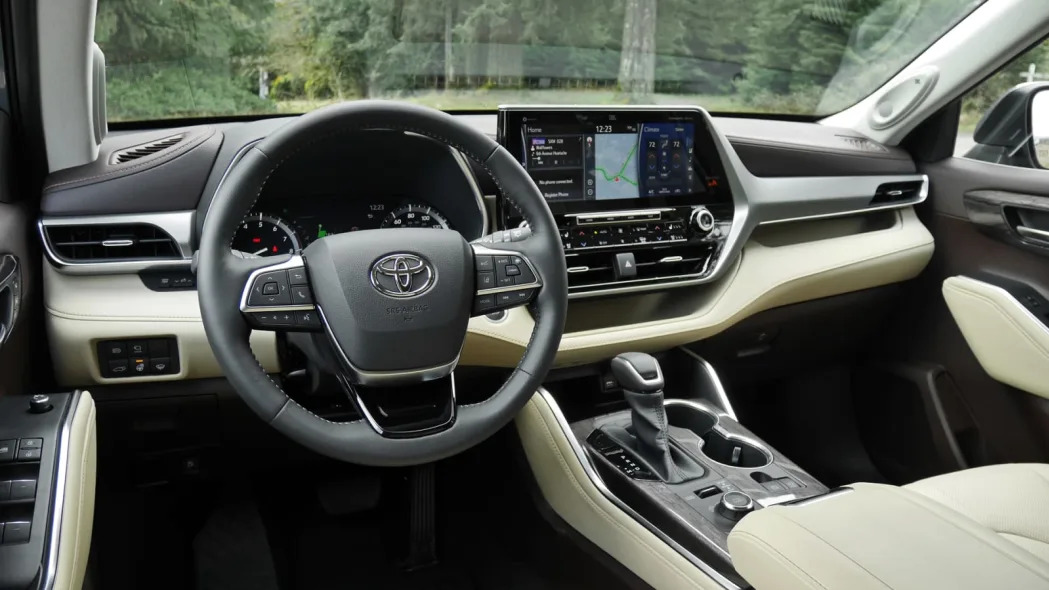
Toyota Highlander Luggage Test
The Highlander gained more space behind its third row for the latest generation, but remains one of the smallest in the segment. We put that space to the test. Note that this was one of the earlier luggage tests we've done with much of the rest of the segment tested thereafter. You can find all Luggage Tests here.
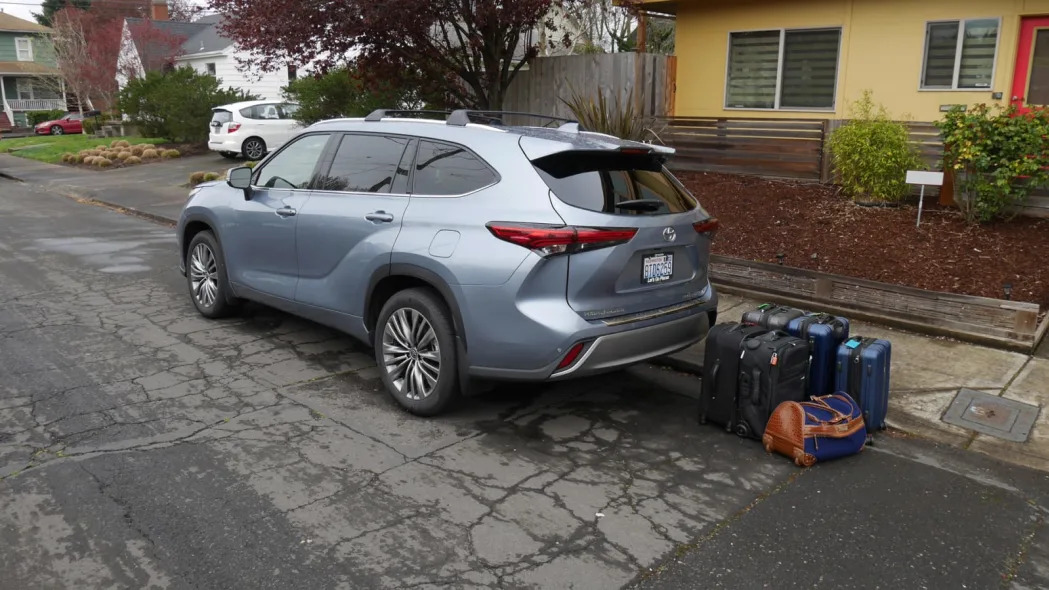
2020 Toyota Highlander and Highlander Hybrid First Drive
Our first driving impressions of both the V6 Highlander and the Highlander Hybrid, including more information about what's new, its engineering and design.

How much is the 2023 Toyota Highlander price and what features are available?
Pricing starts at $37,755 for the base turbo-powered Highlander L, including the $1,335 destination charge. Pricing for the Highlander Hybrid pricing starts at $41,555, but its base trim is the LE. All-wheel drive is a $1,600 to $1,950 option depending on the trim level.
Even the base Highlander L comes standard with a full complement of safety tech (see Safety section), adaptive cruise control, LED headlights with automatic high beams, proximity entry and push-button start, three-zone climate control, an eight-way power driver seat, cloth upholstery, five USB ports (three front, two middle, all Type-C except one Type-A at the front), wireless Apple CarPlay, Android Auto, an 8-inch touchscreen and a six-speaker sound system. The LE, which serves as the base Hybrid trim, has a few key upgrades including a power liftgate, leather-wrapped steering wheel and blind-spot monitoring, but choosing it isn't a must.
Besides slathering on extra equipment, there are some key differences to be aware of in regards to the upper trim levels. The XSE (pictured below) is only available with the turbo engine, has sportier suspension and steering tuning, plus different styling and interior color options. It also offers the more advanced torque-vectoring all-wheel drive system, which is also optional on the Limited and Platinum. Finally, the Bronze Edition adds a variety of bronze-colored accents to what is otherwise a Highlander Hybrid XLE.
You can find a full breakdown of features, specs and local pricing for the 2023 Toyota Highlander here and for the 2023 Highlander Hybrid here. All prices below include the $1,335 destination charge and are for front-wheel-drive models. All-wheel drive is a $1,600 to $1,950 option based on trim.
L: $37,755
LE: $40,155
XLE: $43,155
XSE: $44,750
Limited: $47,410
Platinum: $50,610
Hybrid LE: $41,555
Hybrid XLE: $44,555
Hybrid Bronze Edition: $47,115
Hybrid Limited: $48,810
Hybrid Platinum: $52,010

What are the Highlander safety ratings and driver assistance features?
Every 2023 Toyota Highlander includes standard forward collision warning with pedestrian and cyclist detection, automatic emergency braking, lane-keeping assist, automatic high beams and adaptive cruise control with steering assistance. All but the base L trim includes blind-spot and rear cross-traffic warning. The Limited and Platinum get reverse automatic emergency braking.
The Insurance Institute for Highway Safety named the Highlander a Top Safety Pick+ for its best-possible crash protection and crash prevention scores. Its headlight ratings varied depending on trim level, and its LATCH anchors received a rating of "Good" for ease of use. The National Highway Traffic Safety Administration gave the Highlander five out of five stars for overall crash protection, along with a four-star frontal rating and five-star side rating.
Related video:
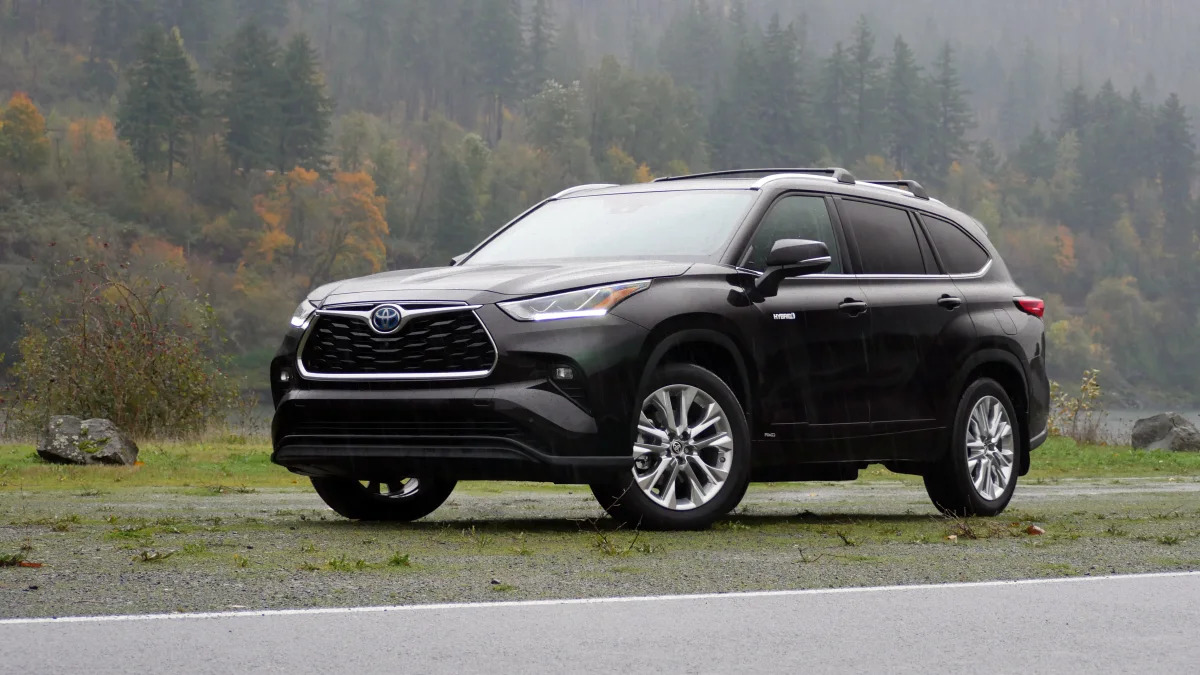









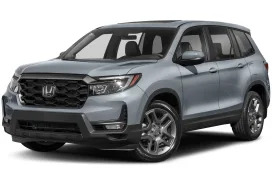


Sign in to post
Please sign in to leave a comment.
Continue